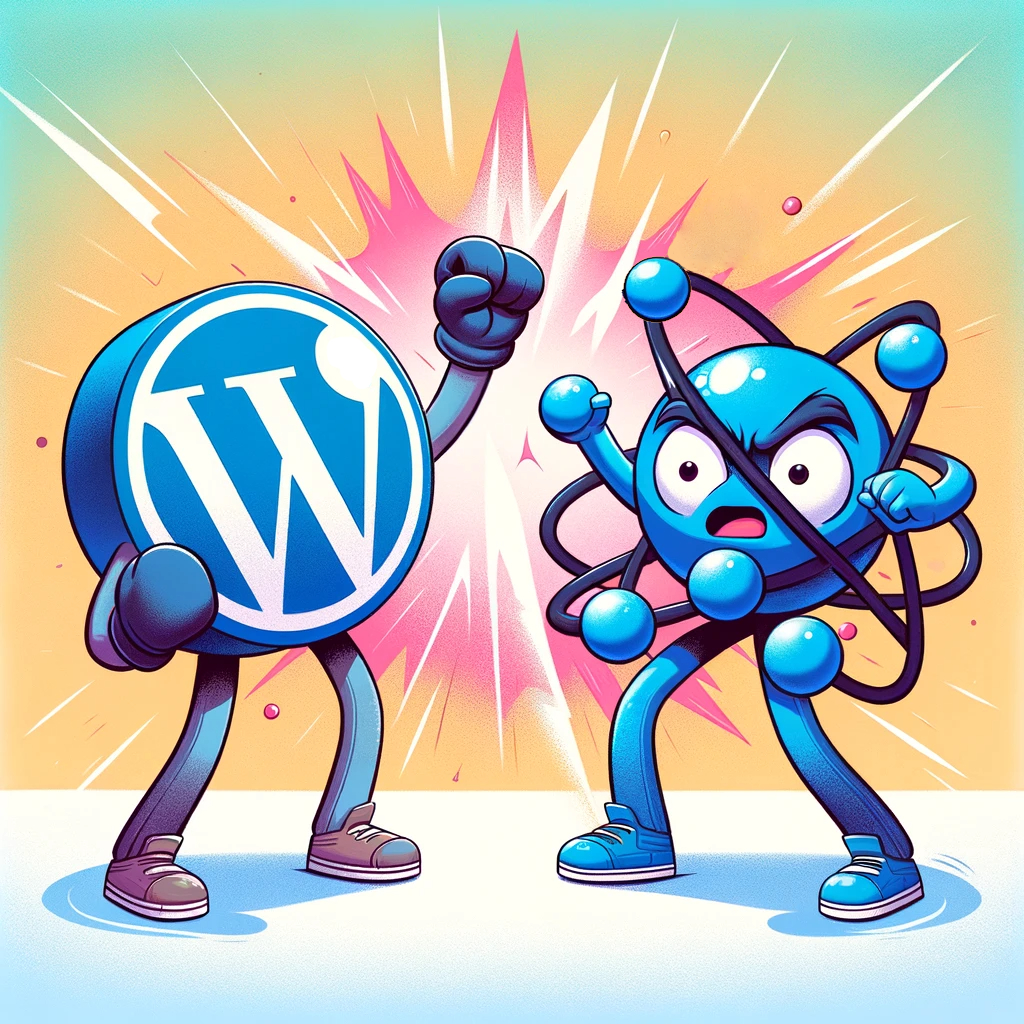Table of Contents
Hello again, and Happy New Year! Thank you so much for sticking around and supporting WordPress Whispers, as I strive to give you the tools to enhance your WordPress sites with the power of JavaScript and the WordPress REST API. It truly means the world to me. So, cheers to YOU, and to the wonderful challenges and opportunities we will encounter together this year🥂. As we start the new year, the landscape of web development continues to shift, bringing new challenges and opportunities. Today, we’re going to look at a question I see a lot of you asking – how do I know whether to use WordPress, or React, for my project? The answer really depends on the kind of project you are building. It may even surprise you to learn that it’s becoming increasingly feasible to use both, together! But not to worry! We will review, in detail, each platform’s uses, strengths, and weaknesses, so that by the end of this article, you will have a solid understanding of which direction you should go.
WordPress: The Ever-Evolving CMS Giant
WordPress, a name synonymous with web development, has undergone a remarkable transformation over its 19+ years of existence. Starting as a blogging platform, it has evolved into the world’s most dominant content management system. What makes WordPress so popular is its versatility, offering a wide array of features, plugins, and third-party service integrations. These tools have enabled WordPress to adapt to the needs of individuals and businesses alike, ensuring scalability and growth.
In 2023, several key trends are shaping WordPress development:
- Enhanced Gutenberg features for easier editing and full-site customization.
- Adoption by larger enterprises, thanks to its customizability and ability to handle significant traffic.
- Rising popularity of headless WordPress, offering more agility in web development.
- Expansion of WooCommerce, driving eCommerce innovation.
- Focus on voice search optimization, in response to the rise of voice-assisted devices.
- Improvements in performance and accessibility, making websites faster and more inclusive.
React.js: The Front-End Powerhouse
React.js, since its inception in 2013, has become a cornerstone in front-end web development. This JavaScript library, created by Facebook, has garnered widespread acclaim for its simplicity, flexibility, and high performance. In the realm of React.js, 2023 is a year of significant advancements and trends:
- React Native‘s growing prominence in mobile app development.
- The adoption of serverless architecture for cost-effective, scalable applications.
- Utilization of static site generators like Gatsby and Next.js for enhanced SEO and user experience.
- The shift towards component-based design systems for improved UI design and consistency.
- Embracing functional programming for more efficient and maintainable code.
- Integration of machine learning for smarter, personalized applications.
- Continued reliance on Redux for state management in React applications.
- Performance optimizations to handle growing application complexity.
- Increasing use of TypeScript for better code maintainability.
- Introduction of the ESLint plugin for code quality and consistency.
- React Suspense for more efficient data fetching and error handling.
- Advancements in JSX for more expressive and readable code.
- The introduction of Concurrent Mode for responsive and smooth UIs.
- Enhanced developer tools for improved debugging and profiling.
Which Should You Choose – WordPress vs React?
Deciding whether to build your website with WordPress or React hinges on understanding their distinct capabilities and how they align with your project’s goals. WordPress offers a user-friendly, feature-rich environment ideal for content-driven websites, blogs, and eCommerce platforms. React, on the other hand, excels in creating dynamic, high-performance web applications, making it a go-to for developers requiring extensive customization and advanced UI capabilities.
As we delve deeper into comparing WordPress and React, it’s essential to keep these differences in mind. Whether you’re a seasoned developer or a beginner, aligning your choice with your project’s specific requirements will be key to success. Stay tuned as we explore the development processes of these powerful platforms in the following sections, offering insights and practical advice to help you make the best choice for your web development needs.
Further Reading:
23 WordPress trends & predictions for 2023
The Top JavaScript Trends to Watch in 2023
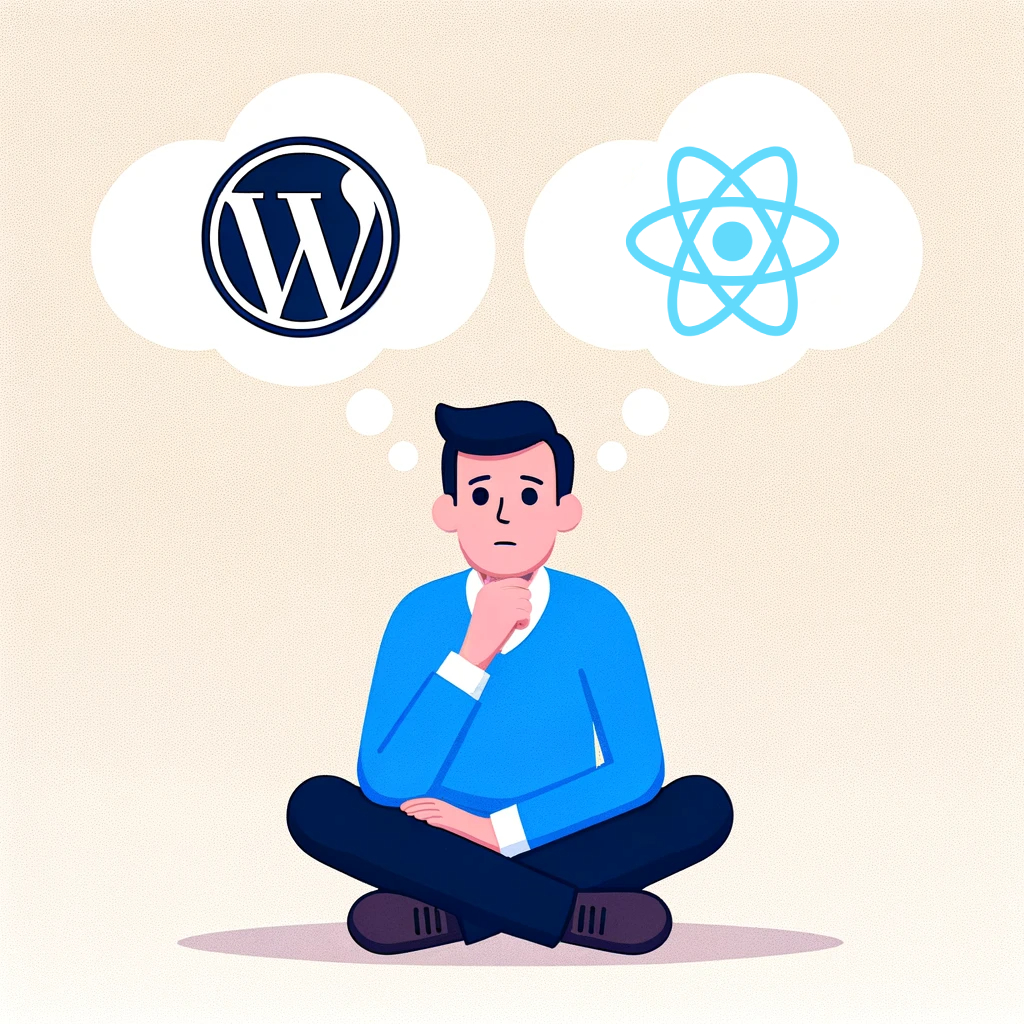
Understanding WordPress vs React
The WordPress vs React debate highlights the strengths and unique features of these two powerful platforms. Let’s delve into what makes each platform stand out.
What is WordPress?
WordPress, a household name in the digital realm, has evolved significantly since its inception. Originally designed as a blogging platform, it has transformed into the most widely used content management system (CMS) on the internet. Powering an impressive 43% of all websites, WordPress’s evolution reflects its adaptability and widespread appeal.
Key Features of WordPress:
- Ease of Use: WordPress is renowned for its user-friendly interface, making website creation and management accessible to everyone, regardless of technical expertise.
- Customization Options: With an extensive library of themes and plugins, WordPress allows for immense customization, enabling users to tailor their sites to meet specific needs and aesthetics.
- SEO-Friendly: WordPress sites are structured to be SEO-friendly, enhancing visibility in search engine results, which is crucial for digital success.
- Multilingual Support: Catering to a global audience, WordPress supports multiple languages, allowing for the creation of diverse, inclusive, and multilingual websites.
- Community Support: A vast and active community of developers, users, and enthusiasts constantly contribute to WordPress’s growth, offering support, resources, and innovations.
What is React?
React has rapidly risen to prominence in the web development community. Developed by Facebook, this JavaScript library is specifically designed for building user interfaces, particularly for single-page applications. Its component-based architecture has revolutionized the way developers approach front-end development.
Key Features of React:
- Component-Based Architecture: React’s core strength lies in its ability to break down complex user interfaces into individual, reusable components, enhancing maintainability and scalability.
- Virtual DOM: React employs a virtual DOM, which optimizes rendering and ensures high performance. This feature allows for minimal page refreshes, leading to smoother and faster user experiences.
- High Performance: React is designed for efficiency, from its fast rendering with the virtual DOM to various optimization techniques, ensuring applications run smoothly and responsively.
- Reusable Components: The use of reusable components in React not only speeds up the development process but also ensures consistency across different parts of the application, improving the overall quality and maintainability of the code.
When comparing WordPress vs React, it’s evident that each platform has its distinct advantages and ideal use cases. WordPress offers a comprehensive, user-friendly solution for content-focused websites and blogs, while React provides the tools necessary for developing dynamic, high-performance web applications. Understanding these platforms’ unique features and capabilities is crucial in choosing the right tool for your web development project. Let’s continue to explore more aspects of these powerful platforms, offering insights to help you make the best choice for your needs.
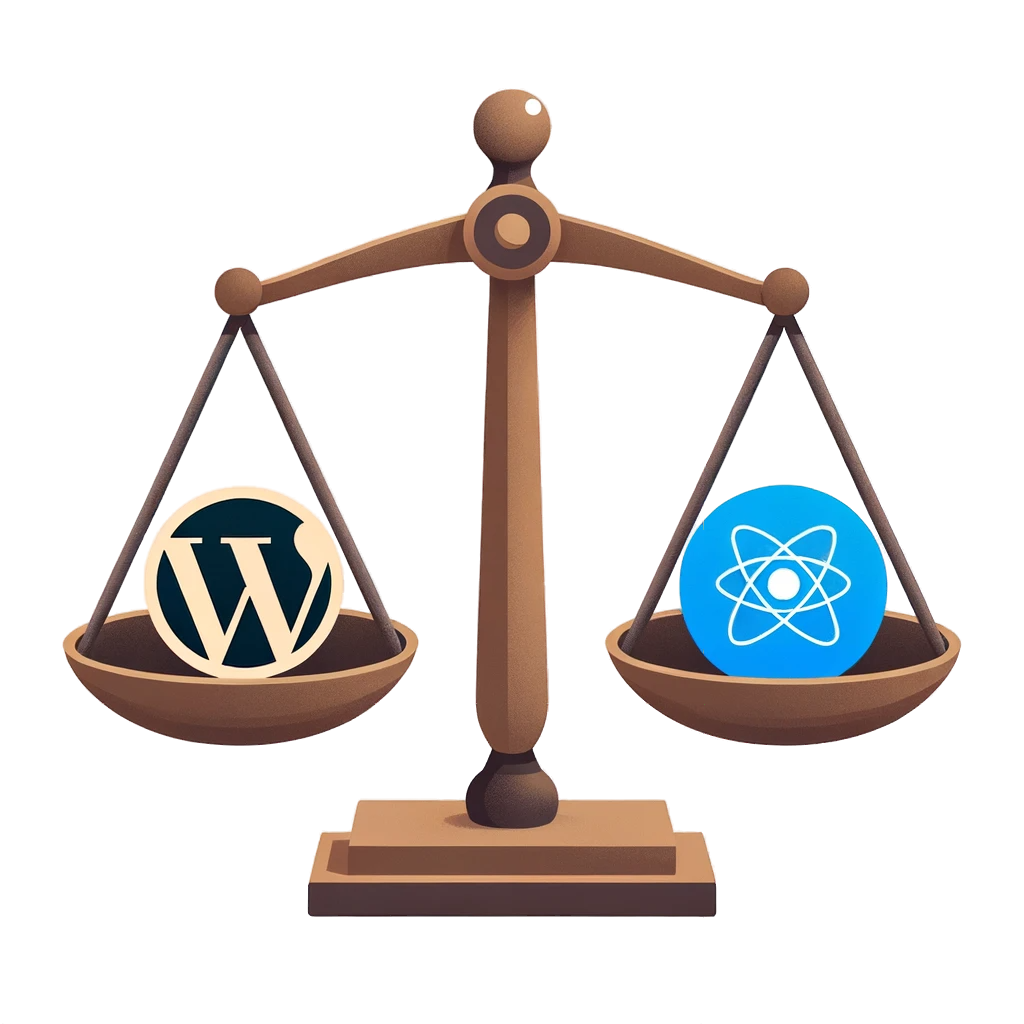
Comparative Analysis: React vs WordPress
The WordPress vs React comparison is a topic of keen interest, as each platform brings its unique approach, flexibility, and performance considerations, offering varied solutions to different web development needs.
Development Approach
WordPress: Template-Based Architecture
WordPress operates on a template-based architecture. This approach simplifies the process of creating websites by offering a wide array of pre-designed templates and themes. These templates provide a structured framework for website development, enabling users, especially those without extensive coding experience, to easily set up, customize, and manage their websites. The template-based architecture is particularly beneficial for content-focused sites like blogs, news portals, and corporate websites, where consistency and ease of content management are priorities.
React: Component-Based Architecture
In contrast, React embraces a component-based architecture. This methodology involves building web applications with encapsulated components that manage their own state. Each component in React is a self-contained module, which can be combined with other components to create complex UIs. This approach allows for greater flexibility and reusability, making React an excellent choice for developing dynamic and interactive web applications. The component-based architecture is particularly advantageous for single-page applications (SPAs) and complex projects requiring unique, sophisticated user interfaces.
Flexibility and Customization
WordPress: Predefined Templates and Plugins
WordPress is known for its vast array of customizable options through themes and plugins. While these options offer considerable flexibility, they are largely confined to the predefined functionalities of the chosen templates and plugins. This setup is ideal for users who prefer a straightforward, plug-and-play approach to website building, offering ample customization possibilities without the need for extensive programming.
React: More Control Over UI and Custom Solutions
React, on the other hand, offers a higher degree of control over the user interface. It allows developers to build custom solutions from the ground up. This flexibility is particularly beneficial for projects requiring tailor-made UIs and complex interactions. React’s ecosystem, including tools like Redux for state management and React Router for navigation, provides developers with the means to craft bespoke, sophisticated applications.
Performance and Optimization
WordPress: Performance Considerations with Plugins and Themes
Performance in WordPress can be influenced by the choice of plugins and themes. While the vast selection of plugins and themes enables extensive functionality and customization, they can also impact the site’s loading speed and overall performance. Careful selection and regular updates of these elements are crucial to maintaining optimal performance, especially for sites with high traffic volumes.
React: Performance Optimization Through Virtual DOM and Other Techniques
React excels in performance optimization through its use of the Virtual DOM and other advanced techniques. The Virtual DOM allows React to update components efficiently, minimizing the need for costly DOM manipulations. Additionally, React’s capability for server-side rendering, code splitting, and lazy loading further enhances application performance, making it well-suited for handling complex, high-traffic applications.
In summary, when comparing WordPress vs React, it’s clear that each platform caters to different aspects of web development. WordPress offers a user-friendly, template-based approach ideal for content-driven sites, while React provides a more flexible, component-based architecture suited for dynamic and complex web applications.
Advantages and Disadvantages of WordPress vs React
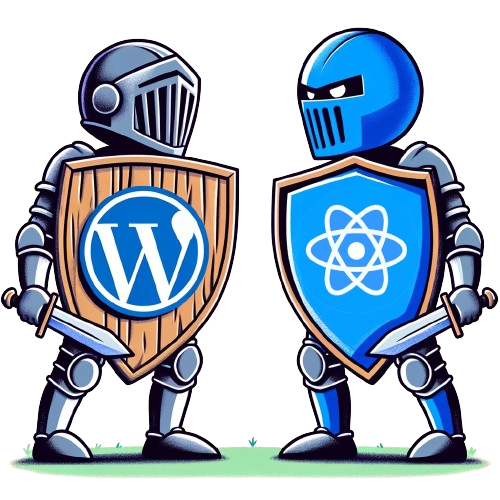
When diving into the WordPress vs React discussion, it’s essential to weigh the advantages and disadvantages of each platform. This comparison helps in making an informed decision based on the specific requirements of your web development project.
Advantages of WordPress
1. User-Friendliness: WordPress is celebrated for its intuitive interface, making it a favorite among beginners and non-technical users. The ease of setting up a website, adding content, and managing it is unmatched, which is a significant advantage for those new to web development.
2. SEO Optimization: Built with SEO in mind, WordPress simplifies the process of optimizing your website for search engines. With plugins like Yoast SEO, it becomes even easier to enhance your site’s visibility in search engine results.
3. E-Commerce Capabilities: WordPress, particularly with WooCommerce, offers robust e-commerce solutions. This integration allows for the creation of versatile online stores with extensive features like inventory management, payment processing, and customer engagement.
4. Mobile Responsiveness: Most WordPress themes are designed to be mobile responsive, ensuring that websites look and function well on various devices, a crucial feature in our increasingly mobile-centric world.
5. Vast Plugin Library: The extensive library of plugins available in WordPress means you can add almost any functionality imaginable to your website, from social media integration to complex security solutions.
Disadvantages of WordPress
1. Security Vulnerabilities: WordPress sites can be vulnerable to security threats, especially if plugins and themes are not regularly updated or if weak passwords are used.
2. Technical Expertise Requirements: While WordPress is user-friendly, some technical know-how is required for more complex tasks like custom theme development or troubleshooting technical issues.
3. Plugin Compatibility Issues: With the vast array of plugins available, compatibility issues can arise, potentially leading to website malfunctions or security vulnerabilities.
Advantages of React
1. High Performance: React’s efficient update and rendering process, aided by the Virtual DOM, ensures high performance, particularly crucial for complex and dynamic web applications.
2. Reusable Components: The component-based architecture in React allows for reusing code across different parts of the application, enhancing efficiency and consistency in development.
3. SEO-Friendliness: With server-side rendering capabilities, React can be optimized for search engines, making it a suitable choice for projects where SEO is a priority.
4. Strong Community Support: React’s widespread popularity ensures robust community support, offering an abundance of resources, tools, and libraries to assist developers in their projects.
Disadvantages of React
1. Steep Learning Curve: React’s advanced features and unique syntax can be challenging for beginners, requiring a solid understanding of JavaScript and modern web development concepts.
2. Reliance on Third-Party Libraries: While React provides the core framework, developers often rely on third-party libraries for additional functionalities, which can add complexity and maintenance challenges.
3. Limited Backward Compatibility: Frequent updates in React can lead to compatibility issues with older versions, requiring developers to stay current with the latest changes and adjustments in their code.
Practical Use Cases: WordPress vs React
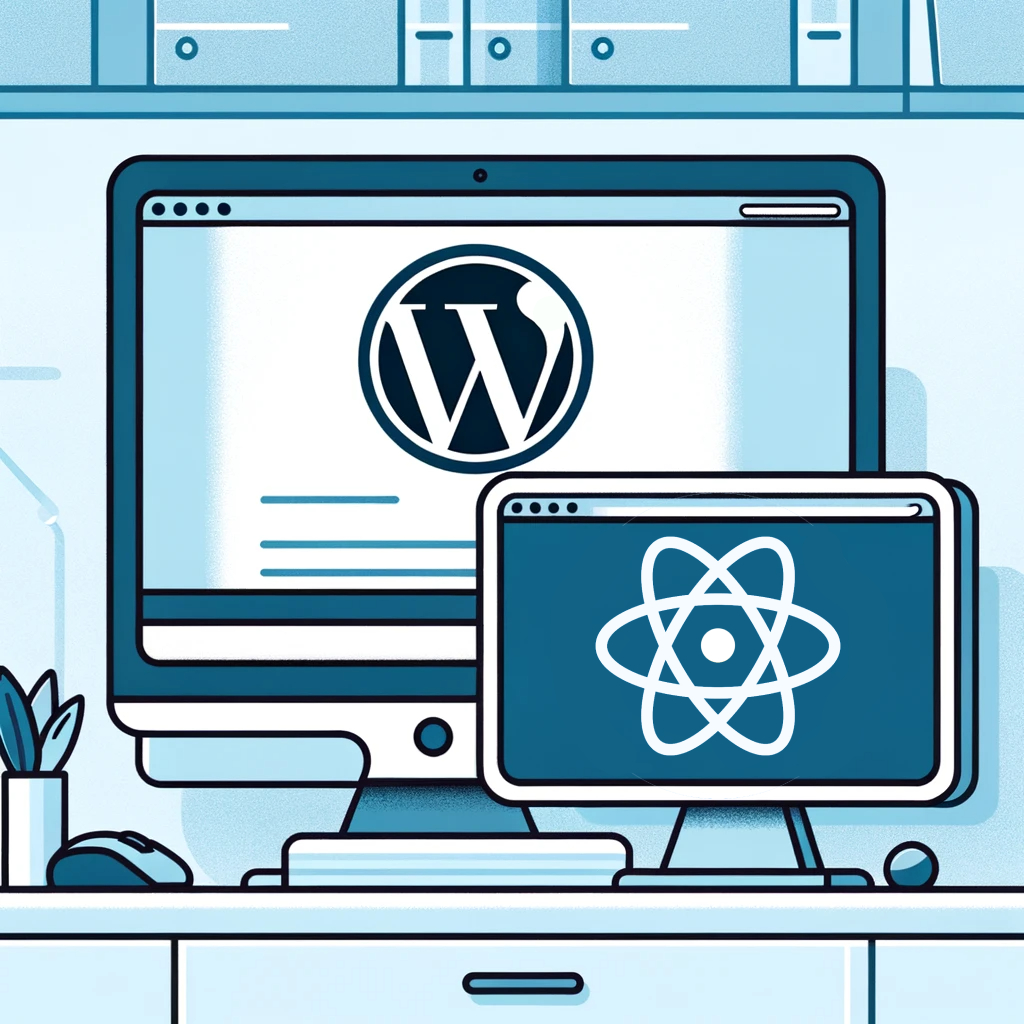
When navigating the WordPress vs React landscape, understanding the practical use cases of each platform is essential. This insight helps in making a well-informed decision, ensuring that the chosen technology aligns perfectly with the needs of your project.
When to Choose WordPress
1. Content-Focused Websites: WordPress is the go-to choice for content-driven websites like blogs, news sites, and online magazines. Its user-friendly content management system makes it easy to regularly update and manage large volumes of content, an essential aspect of such websites.
2. Small Business Websites: For small businesses looking to establish an online presence, WordPress offers a cost-effective, easy-to-manage solution. The platform provides a multitude of themes and plugins that help in creating a professional and functional website without needing extensive technical skills.
3. Portfolio Sites: Creative professionals such as artists, photographers, and writers can benefit greatly from WordPress. Its vast array of visually appealing themes and easy content management allows for showcasing work in an organized and attractive manner.
When to Choose React
1. Complex Web Applications: React is ideal for developing more complex web applications that require dynamic user interfaces and state management. Its component-based architecture makes it easier to handle intricate UIs and data-intensive processes.
2. Dashboards: For applications that require real-time data presentation, such as administrative dashboards, React’s efficient data handling and rendering capabilities make it a superb choice. React ensures smooth and interactive user experiences, even when dealing with large datasets and real-time updates.
3. Analytics Platforms: When building analytics platforms, React’s ability to handle complex operations and render data-driven interfaces is invaluable. It allows for the creation of detailed, interactive charts and graphs that are crucial for analytics tools.
4. Single-Page Applications (SPAs): React is particularly well-suited for creating SPAs. SPAs offer a more fluid user experience by loading all content through a single web page dynamically. React’s efficient update and rendering system make it perfect for these types of applications, where user interaction and responsiveness are key.

Integrating React with WordPress
In the realm of web development, the integration of React with WordPress presents a powerful synergy, combining the robust content management capabilities of WordPress with the dynamic and responsive interface of React. This fusion offers a range of possibilities, particularly beneficial in scenarios where you need the strengths of both platforms.
Exploring the Synergy Between React and WordPress
Headless WordPress with React: One of the most exciting integrations of React and WordPress is in the form of Headless WordPress. In this setup, WordPress serves as the backend content management system, managing all the content, while React is used for the frontend, presenting the content to the users. This separation of concerns allows developers to leverage WordPress’s powerful CMS capabilities alongside React’s dynamic and responsive UI.
In a headless setup, WordPress’s REST API is used to fetch content from the WordPress backend and deliver it to the React frontend. This approach provides the flexibility to use WordPress for content management and React for creating a rich, interactive user experience.
Gutenberg and React: The Gutenberg editor in WordPress is another area where React plays a pivotal role. Gutenberg, built using React, provides a more intuitive and block-based approach to content creation in WordPress. It allows for the design and arrangement of content blocks within the WordPress interface, which React then renders on the frontend.
Use Cases of Headless WordPress with React
1. High-Performance Websites: For websites where performance is a top priority, such as high-traffic blogs or news sites, using React with headless WordPress ensures that the site can handle large volumes of traffic while providing a smooth user experience.
2. Custom Web Applications: When building web applications that require a powerful backend for content management but also need a highly interactive and responsive frontend, integrating React with headless WordPress is an ideal solution.
3. E-commerce Platforms: For e-commerce sites seeking to combine WordPress’s extensive content management and e-commerce functionalities (like WooCommerce) with the interactive shopping experience provided by React, this integration offers a compelling solution.
Integrating React with WordPress harnesses the strengths of both platforms, offering a versatile solution for various web development needs. Whether you are looking to build a high-performance website, a custom web application, or an interactive e-commerce platform, this combination opens up a world of possibilities, ensuring that your site is both easy to manage and engaging for users. Understanding how to effectively integrate these two powerful tools can significantly enhance the functionality and user experience of your web projects.
Comparing Costs: WordPress vs React

In the WordPress vs React debate, understanding the cost implications certainly plays a role in making an informed decision. This comparison includes initial setup costs, development costs, maintenance expenses, scalability considerations, and e-commerce capabilities.
Initial Setup Costs
WordPress:
- Domain Name: Typically, domain registration for WordPress sites costs between $10 to $20 annually.
- Hosting: Options range from self-hosting (approximately $3 to $10 per month) to managed WordPress hosting plans (varying from free to about $45 per month on platforms like WordPress.com).
- Themes and Plugins: While many are free, premium themes and plugins can range from $50 to $200 or more, depending on requirements.
React:
- Domain Name: Similar to WordPress, a domain name is required, with costs in a comparable range.
- Hosting: React applications need server hosting, which can start from around $5 per month and increase based on the hosting provider and resources needed.
- Development Tools: Many React tools and libraries are open-source and free, but some premium tools may incur additional costs.
Development Costs
WordPress:
- Customization: Depending on complexity, customizing a theme can range from $500 to $5,000 or more.
- Content Creation: Costs vary based on whether content is self-written or outsourced, with prices ranging from $20 to $100 per article.
- Maintenance: Regular maintenance, including updates and security, can necessitate hiring a developer, adding around $50 to $150 monthly.
React:
- Development Time: Building a React application from scratch can be time-consuming, affecting costs. React developer rates can range anywhere from $25 to $150 per hour.
- Content Integration: Similar to WordPress, costs for content creation apply.
- Maintenance: Ongoing maintenance for React applications can be similar to WordPress in terms of costs.
Maintenance Expenses
Both WordPress and React require ongoing maintenance:
- WordPress: Updating plugins and themes and conducting security audits are essential for smooth operation.
- React: Regular updates for React and its libraries are necessary for maintaining security and performance.
Considerations for Scalability and E-commerce
WordPress:
- Scalability: Suitable for small to medium-sized websites. For larger sites with high traffic, more robust hosting solutions or custom development might be needed.
- E-commerce: Platforms like WooCommerce add additional costs for e-commerce functionality.
React:
- Scalability: React offers greater flexibility for scalable web applications, suitable for both small and large-scale projects.
- E-commerce: Building e-commerce functionality can be more custom with React, potentially increasing development costs.
When comparing the costs of WordPress vs React, the choice depends on your project’s specific requirements. WordPress may be more cost-effective for smaller, less customized sites, while React can offer advantages for complex, highly customized projects. Both platforms incur ongoing costs for hosting, maintenance, and development.

Popular Plugins and Libraries: WordPress vs React
When comparing WordPress and React, a key aspect to consider is the range of plugins and libraries each offers. These tools enhance the functionality and efficiency of websites and applications. Here’s an overview of some popular plugins and libraries for WordPress and React, respectively.
Popular WordPress Plugins
- Yoast SEO: Yoast SEO is an essential plugin for any WordPress site focused on improving search engine optimization. It offers comprehensive tools for optimizing content, meta tags, and generating XML sitemaps, thus enhancing your site’s SEO performance.
- WooCommerce: For those venturing into e-commerce, WooCommerce is the top choice. It transforms a WordPress site into a fully functional online store, providing extensive features for product management, payment gateways, and inventory control.
- Jetpack: Developed by Automattic, the company behind WordPress, Jetpack is a versatile plugin that enhances website performance, security, and analytics. It offers features like lazy loading images, downtime monitoring, and performance analytics, crucial for maintaining a reliable and efficient website.
- WP Super Cache: In the world of web development, speed is crucial. WP Super Cache generates static HTML files from your dynamic WordPress site, significantly improving loading times and reducing server load.
Key React Libraries
- React Router: For building single-page applications (SPAs) with React, React Router is indispensable. It enables client-side routing, allowing seamless navigation between pages without full page reloads.
- Redux: As applications grow in complexity, managing state becomes a challenge. Redux provides a predictable state container, streamlining state management across your React application and enhancing debuggability.
- Material-UI: Material-UI is a popular library for UI design in React applications. It follows Google’s Material Design guidelines and offers a vast collection of pre-designed components, making UI development more efficient and consistent.
- Axios: For handling API requests in React, Axios is a widely-used choice. It simplifies making HTTP requests, providing a more manageable way to interact with APIs and handle AJAX requests.
The selection of plugins and libraries is a critical aspect of web development in both WordPress and React. While WordPress offers a range of user-friendly plugins enhancing SEO, e-commerce capabilities, and overall site performance, React’s libraries focus on improving UI design, state management, and API interactions. These tools play a significant role in shaping the functionality and user experience of websites and applications, and understanding their strengths can guide developers in choosing the right platform for their project’s needs.

Final Thoughts
After a thorough comparison of WordPress and React, it’s clear that each platform has distinct strengths tailored to specific web development needs.
WordPress is ideal for users seeking a user-friendly, content-focused platform. It’s perfect for blogs, small business websites, and e-commerce sites, offering a vast array of plugins and themes for customization.
React, on the other hand, shines in creating dynamic, high-performance web applications. It’s the go-to for developers building complex UIs, SPAs, and interactive web experiences.
The decision between WordPress vs React hinges on your project’s requirements and your development team’s expertise. Consider the nature of your project, the desired user experience, and the technical skills available on your team.
Share Your Thoughts! We’d love to hear your experiences and thoughts on WordPress and React. Please feel free to share your insights in the comments below.
Join Our Community: For more insights and updates on WordPress, React, and the WordPress REST API, consider following WordPress Whispers. By subscribing, you’ll gain access to exclusive content, including the eBook on Headless WordPress, an invitation to our private LinkedIn group, and early access to future courses.




